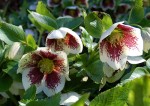
This clump forming perennial native to Greece and Turkey is a member of the buttercup family (Ranunculaceaea) and not related to roses. It has plametely compound leaves with seven to nine leaflets and is eight to sixteen inches wide. The leathery dark green glossy leaves are evergreen in warm climates and so are handsome all winter. The nodding cup-shaped flowers are three to four inches across and have a center of gold stamens and petal-like sepals in white, pink, rose, burgundy, or lettuce green often with dark speckles. They bloom in late winter and early spring for eight to ten weeks. To give the plants the light they need in winter but shade in summer, plant under a deciduous tree. Good cut flower adding a unique touch to winter bouquets.
Type: Herbaceous perennial.
Bloom: Rose, pink, lavender, burgundy, and lettuce green; may be speckled with a darker color; winter, early spring.
Size: 18” H x 18” W.
Light: Needs shade in the summer but sun in the winter.
Soil: Fertile, high in organic matter, moist, well drained; pH 6.5 to 8.5 (slightly acid to somewhat alkaline).
Fertilizer: Apply organic compost in the spring and fall.
Hardiness: Zones 4-9.
Care: Mulch in spring and fall to conserve moisture; add organic matter and nutrients; give water during dry spells; may need lime if grown in acid soils so apply lime immediately after blooming.
Pests and Diseases: None of significance.
Propagation: Self seeds easily and seedling may be transplanted; if you must move one, do so immediately after blooming.
Companion plants: Spring bulbs such as crocus, grape hyacinth, Galanthus elwesii; bergenia, brunneras.
Outstanding Selections: ‘Queen of the Night’ (deep red velvety petals with bright yellow stamens).
Comments: All parts of the plant are poisonous; resent being transplanted; may take 2 years to become established and bloom well but becomes somewhat drought resistant; long lived.
